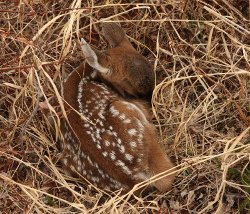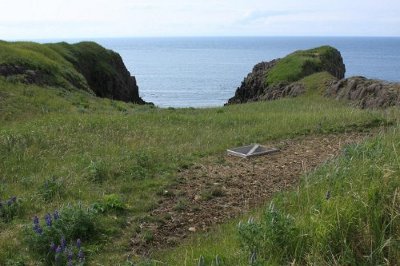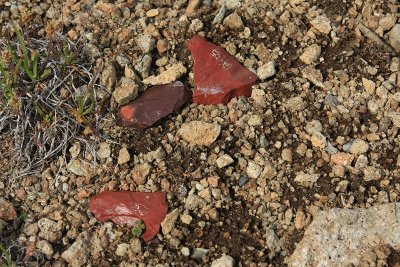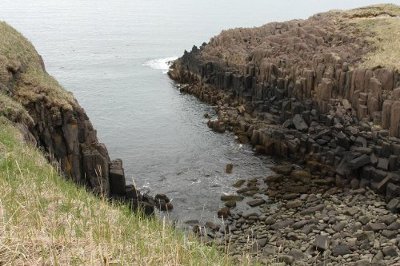
 Share This Page
Share This Page| Home | | Sailing | | Alaska 2010 | |  |  Share This Page Share This Page |

Copyright © 2010, P. Lutus. All rights reserved. Message Page
| Prior years: |
Alaska 2002 |
Alaska 2003 |
Alaska 2004 |
Alaska 2005 Alaska 2006 | Alaska 2007 | Alaska 2008 | Alaska 2009 |
(double-click any word to see its definition)

Figure 1: (foreground) Habitation Site
(background) Baidarka Harbor
(The wooden frame protects important artifacts)

Figure 2: Flint Chips at Village Site (note markings)

Figure 3: The Baidarka (Kayak) Harbor
During my Alaska hikes I have located a very old human habitation, one that dates back about 7,000 years before the present. Because of the presence of unprotected artifacts with cultural and archaeological importance I think my readers will understand if I don't reveal its location.
Figure 1 shows the habitation site, with some original materials including flint and obsidian, and two small points of land extending from the shore in the distance. In the middle of the site there is a wooden frame covering and protecting materials that visiting researchers deemed of particular importance. Figure 2 shows some flint chips at the site, with numbers painted on to assist the researchers who have been studying this location.
When I visit this site (as I do every year) I try to imagine the lives of the people who dwelt here. What did they do, and how did they survive? And what led them to choose this site?
Over the years, by hiking and exploring this site, I have come up with a theory about how and why it was chosen. Figure 3 shows the tiny harbor between the two points of land visible in Figure 1. This harbor is just big enough to protect a kayak from the rough seas in the open water beyond. I think this tiny harbor was the reason for the choice — a kayak is quite controllable on the open ocean in deep water, where even large swells won't upset a boat paddled by someone skilled. The danger comes when approaching shore as the water shallows, where swells will break and possibly throw a kayak and its paddler onto the rocks. But at this site, for the most common wind and wave directions, the tiny harbor would protect a kayaker and allow him to safely beach his boat.
Some of my readers may know that the "big picture" of human migration in this area describes a sequence of explorations and settlements, from what is now eastern Russia and Siberia, across the Bering Strait when it was passable on foot, then to the general area where this site is located, and eventually down to what is now Canada and the U.S. It's important to understand that this migration might have taken thousands of years, with human settlements like this one occupied along the way, rather than a long hike to a specific destination.
There have been many changes in this area since people lived here. Chances are it was much colder then (although a global warming denier I know says it might have been warmer — and who knows?). There was certainly much more wildlife, fish and whales in particular, than there is now. It's my understanding that sea otters were much more plentiful, before they were almost wiped out by the fur trade.
But one thing hasn't changed — the bears are still in charge. We're just visitors in their territory.
| Home | | Sailing | | Alaska 2010 | |  |  Share This Page Share This Page |